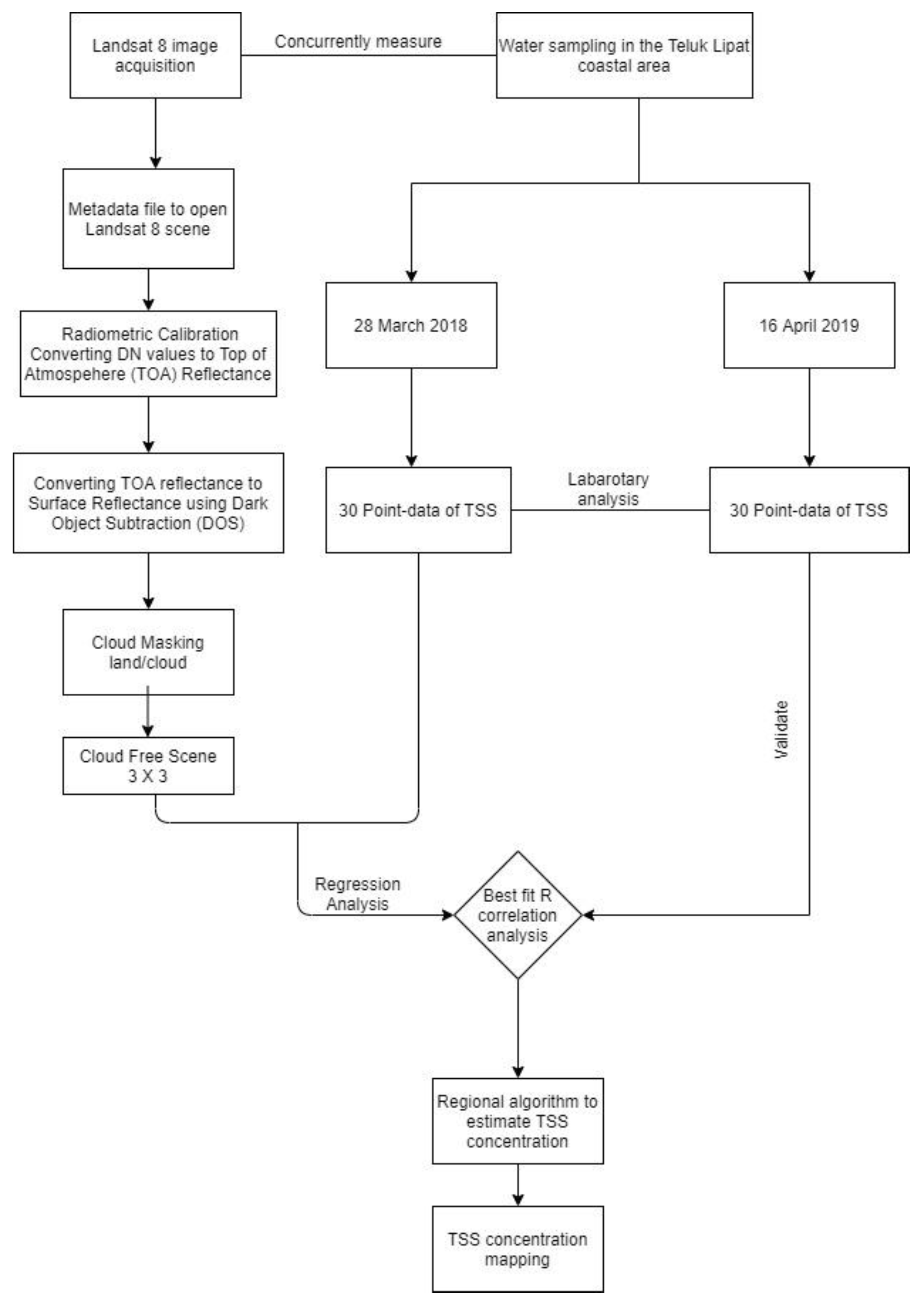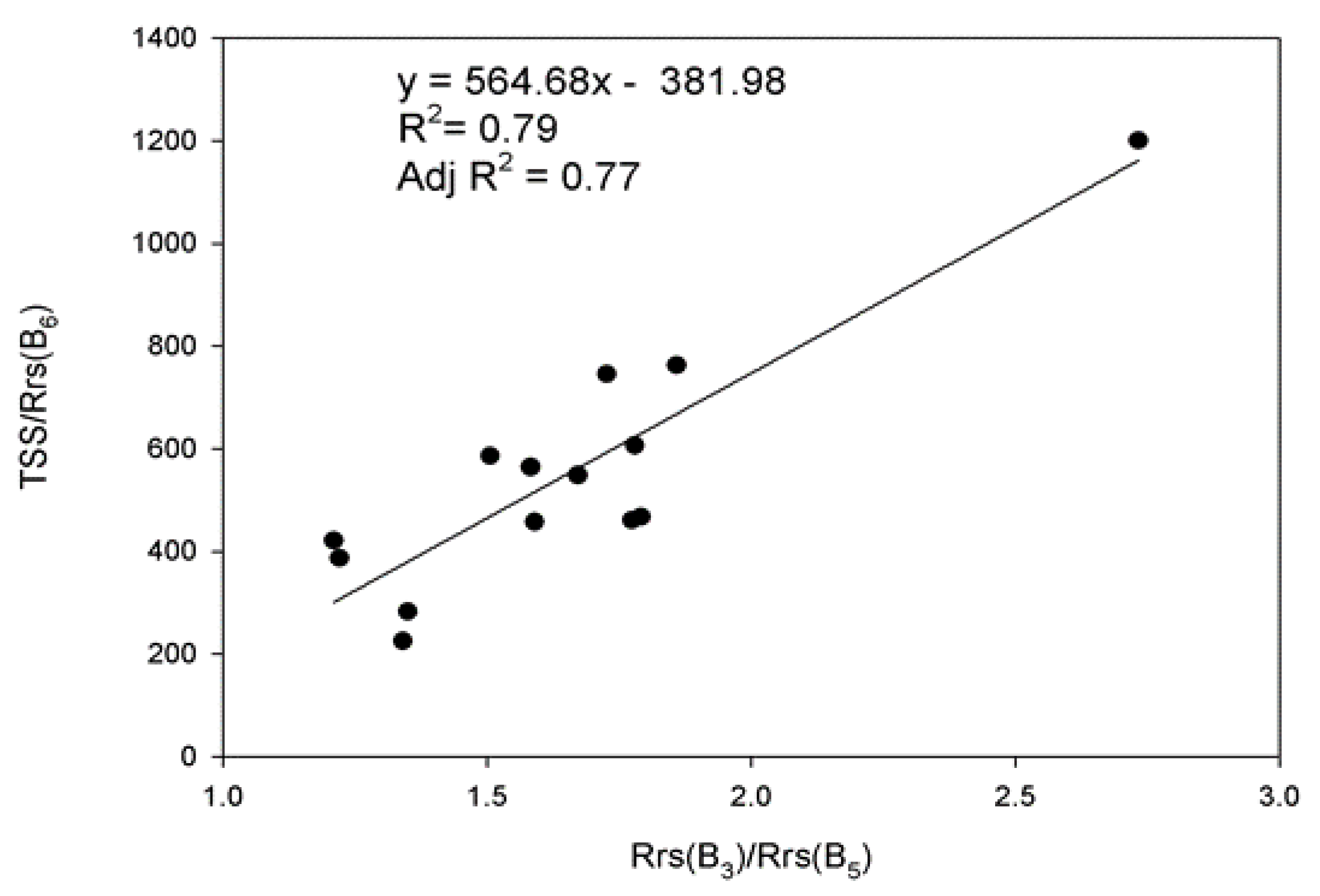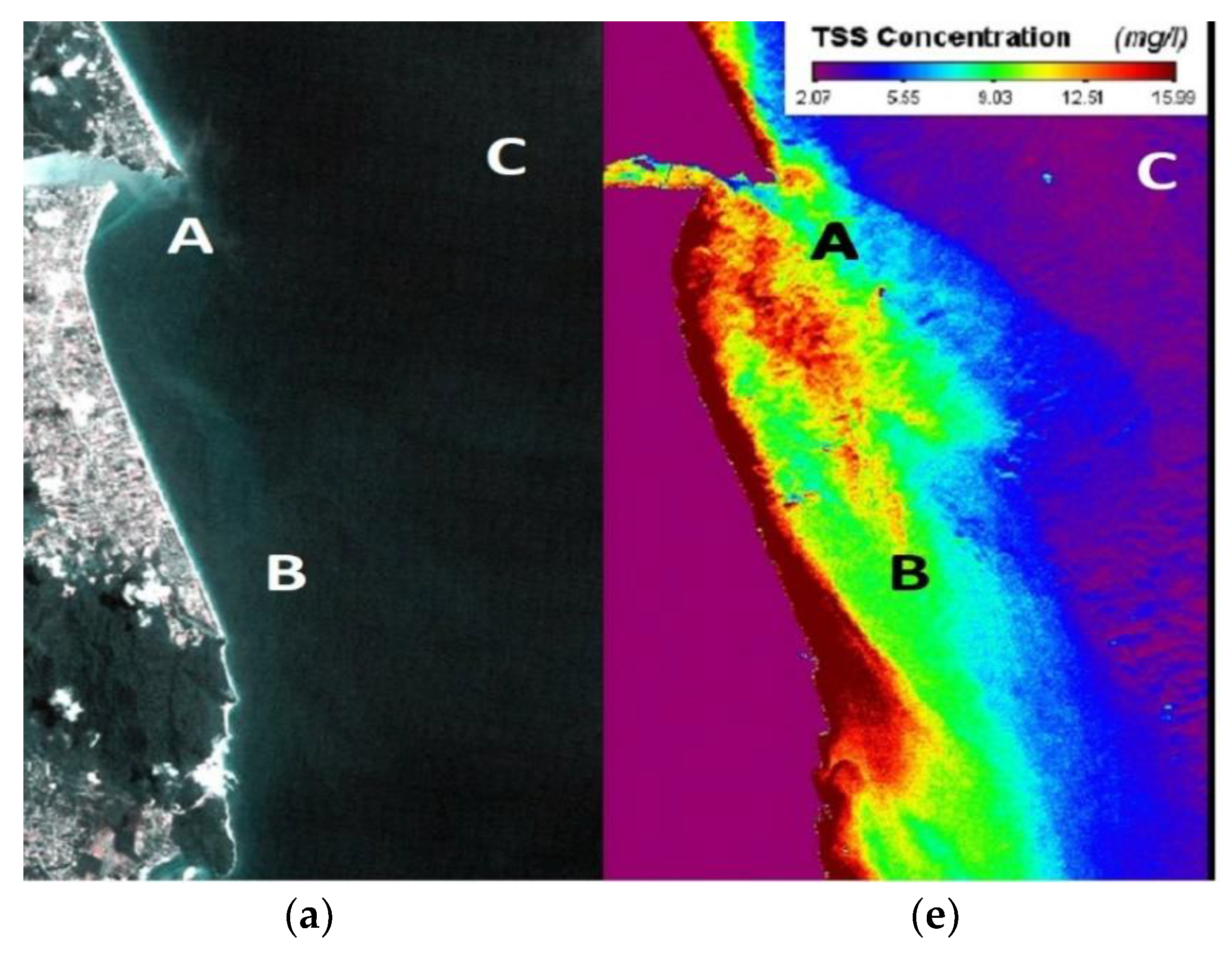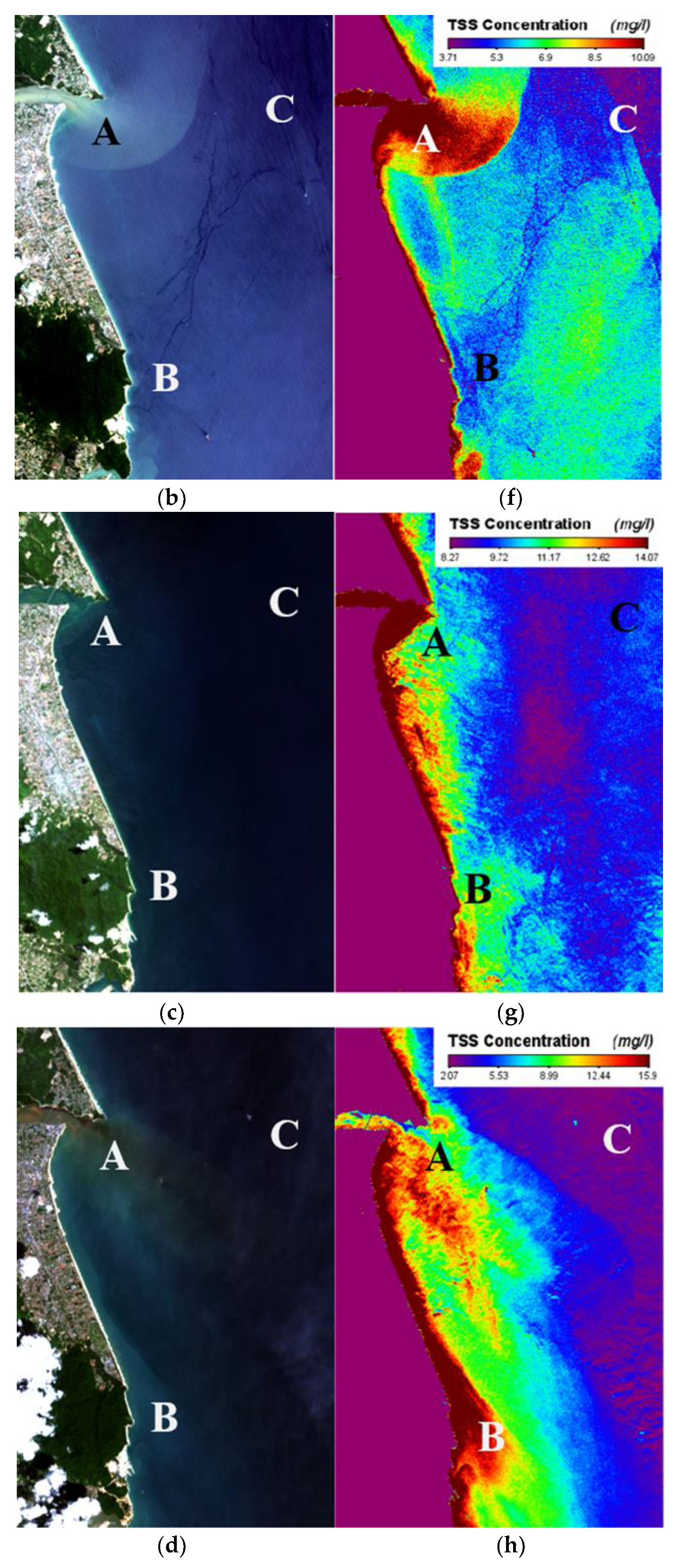Monitoring Total Suspended Sediment Concentration in Spatiotemporal Domain over Teluk Lipat Utilizing Landsat 8 (OLI)
Abstract
:1. Introduction
2. Materials and Methods
2.1. Study Region
2.2. Data Sampling and Analysis
- A = mass of filter + dried residue (mg),
- B = mass of filter (tare weight) (mg)
2.3. Landsat 8 Dataset
2.4. Matchup
2.5. Accuracy Assessment Method of Models
3. Results and Discussion
3.1. Pixel Dimension
3.2. TSS Concentration Algorithm
- x1 = Rrs(B6)
- x2 = Rrs(B3)
- x3 = Rrs(B5)
- a = 564.68, b = 381.98
3.3. Validation of the TSS Concentration Model
3.4. TSS Concentration Mapping
4. Conclusions
Author Contributions
Funding
Institutional Review Board Statement
Informed Consent Statement
Data Availability Statement
Acknowledgments
Conflicts of Interest
References
- Cremon, É.H.; Da Silva, A.M.S.; Montanher, O. Estimating the suspended sediment concentration from TM/Landsat-5 images for the Araguaia River—Brazil. Remote Sens. Lett. 2020, 11, 47–56. [Google Scholar] [CrossRef]
- May, C.L.; Koseff, J.R.; Lucas, L.V.; Cloern, J.; Schoellhamer, D.H. Effects of spatial and temporal variability of turbidity on phytoplankton blooms. Mar. Ecol. Prog. Ser. 2003, 254, 111–128. [Google Scholar] [CrossRef] [Green Version]
- Miller, R.L.; McKee, B.A. Using MODIS Terra 250 m imagery to map concentrations of total suspended matter in coastal waters. Remote Sens. Environ. 2004, 93, 259–266. [Google Scholar] [CrossRef]
- Mayer, L.M.; Keil, R.G.; Macko, S.A.; Ruttenberg, K.C.; Aller, R.C.; Joye, S.B. Importance of suspended participates in riverine delivery of bioavailable nitrogen to coastal zones. Glob. Biogeochem. Cycles 1998, 12, 573–579. [Google Scholar] [CrossRef]
- Vinh, P.Q.; Ha, N.T.T.; Binh, N.T.; Thang, N.N.; Oanh, L.T.; Thao, N.T.P. Developing algorithm for estimating chlorophyll-a concentration in the Thac Ba Reservoir surface water using Landsat 8 Imagery. Vietnam J. Earth Sci. 2019, 41, 10–20. [Google Scholar] [CrossRef] [Green Version]
- Olsen, C.; Cutshall, N.; Larsen, I. Pollutant—Particle associations and dynamics in coastal marine environments: A review. Mar. Chem. 1982, 11, 501–533. [Google Scholar] [CrossRef]
- Ma, W.-X.; Huang, T.; Zhang, Y. A multiple exp-function method for nonlinear differential equations and its application. Phys. Scr. 2010, 82, 1–12. [Google Scholar] [CrossRef]
- Wu, W.; Zheng, H.; Xu, S.; Yang, J.; Liu, W. Trace element geochemistry of riverbed and suspended sediments in the upper Yangtze River. J. Geochem. Explor. 2013, 124, 67–78. [Google Scholar] [CrossRef]
- Phuong, N.T.B.; Tri, V.P.D.; Duy, N.B.; Nghiem, N.C. Remote Sensing for Monitoring Surface Water Quality in the Vietnamese Mekong Delta: The Application for Estimating Chemical Oxygen Demand in River Reaches in Binh Dai, Ben Tre. Vietnam J. Earth Sci. 2017, 39, 256–268. [Google Scholar] [CrossRef] [Green Version]
- Wang, M. Estimation of ocean contribution at the MODIS near-infrared wavelengths along the east coast of the U.S.: Two case studies. Geophys. Res. Lett. 2005, 32, 1–5. [Google Scholar] [CrossRef] [Green Version]
- Ronghua, M.; Junwu, T.; Hongtao, D.; Delu, P. Progress in lake water color remote sensing. J. Lake Sci. 2009, 21, 143–158. [Google Scholar] [CrossRef]
- Mountrakis, G.; Im, J.; Ogole, C. Support vector machines in remote sensing: A review. ISPRS J. Photogramm. Remote Sens. 2011, 66, 247–259. [Google Scholar] [CrossRef]
- Wang, C.; Chen, S.; Li, D.; Wang, D.; Liu, W.; Yang, J. A Landsat-based model for retrieving total suspended solids concentration of estuaries and coasts in China. Geosci. Model Dev. 2017, 10, 4347–4365. [Google Scholar] [CrossRef] [Green Version]
- Zheng, Z.; Li, Y.; Guo, Y.; Xu, Y.; Liu, G.; Du, C. Landsat-Based Long-Term Monitoring of Total Suspended Matter Concentration Pattern Change in the Wet Season for Dongting Lake, China. Remote Sens. 2015, 7, 13975–13999. [Google Scholar] [CrossRef] [Green Version]
- Mukhtar, M.; Manessa, M.; Supriatna, S.; Khikmawati, L. Spatial Modeling of Potential Lobster Harvest Grounds in Palabuhanratu Bay, West Java, Indonesia. Fishes 2021, 6, 16. [Google Scholar] [CrossRef]
- Matthews, M.W. A current review of empirical procedures of remote sensing in inland and near-coastal transitional waters. Int. J. Remote Sens. 2011, 32, 6855–6899. [Google Scholar] [CrossRef]
- Maier, P.; Keller, S.; Hinz, S. Deep Learning with WASI Simulation Data for Estimating Chlorophyll a Concentration of Inland Water Bodies. Remote Sens. 2021, 13, 718. [Google Scholar] [CrossRef]
- Lee, Y.K.; Ng, H.T. An empirical evaluation of knowledge sources and learning algorithms for word sense disambiguation. In Proceedings of the 2002 Conference on Empirical Methods in Natural Language Processing (EMNLP 2002), Philadelphia, PA, USA, 6–7 July 2002; pp. 41–48. [Google Scholar]
- Brockman, G.; Cheung, V.; Pettersson, L.; Schneider, J.; Schulman, J.; Tang, J.; Zaremba, W. OpenAI Gym. 2016, pp. 1–4. Available online: http://arxiv.org/abs/1606.01540 (accessed on 10 June 2021).
- Gege, P. The water color simulator WASI: An integrating software tool for analysis and simulation of optical in situ spectra. Comput. Geosci. 2004, 30, 523–532. [Google Scholar] [CrossRef]
- Niroumand-Jadidi, M.; Bovolo, F.; Bruzzone, L.; Gege, P. Inter-Comparison of Methods for Chlorophyll-a Retrieval: Sentinel-2 Time-Series Analysis in Italian Lakes. Remote Sens. 2021, 13, 2381. [Google Scholar] [CrossRef]
- Nechad, B.; Ruddick, K.; Park, Y. Calibration and validation of a generic multisensor algorithm for mapping of total suspended matter in turbid waters. Remote Sens. Environ. 2010, 114, 854–866. [Google Scholar] [CrossRef]
- Hajigholizadeh, M.; Moncada, A.; Kent, S.; Melesse, A. Land–Lake Linkage and Remote Sensing Application in Water Quality Monitoring in Lake Okeechobee, Florida, USA. Land 2021, 10, 147. [Google Scholar] [CrossRef]
- Balasubramanian, S.V.; Pahlevan, N.; Smith, B.; Binding, C.; Schalles, J.; Loisel, H.; Gurlin, D.; Greb, S.; Alikas, K.; Randla, M.; et al. Robust algorithm for estimating total suspended solids (TSS) in inland and nearshore coastal waters. Remote Sens. Environ. 2020, 246, 111768. [Google Scholar] [CrossRef]
- Feng, L.; Hu, C.; Chen, X.; Song, Q. Influence of the Three Gorges Dam on total suspended matters in the Yangtze Estuary and its adjacent coastal waters: Observations from MODIS. Remote Sens. Environ. 2014, 140, 779–788. [Google Scholar] [CrossRef]
- Di Trapani, A.; Corbari, C.; Mancini, M. Effect of the Three Gorges Dam on Total Suspended Sediments from MODIS and Landsat Satellite Data. Water 2020, 12, 3259. [Google Scholar] [CrossRef]
- Ritchie, F.R.; Ritchie, M.J.R.; Schiebe, J.C. Remote sensing of Ss in surface water. Photogramm. Eng. Remote Sens. 1976, 42, 1539–1545. [Google Scholar]
- Doxaran, D.; Froidefond, J.-M.; Castaing, P. Remote-sensing reflectance of turbid sediment-dominated waters. Reduction of sediment type variations and changing illumination conditions effects by use of reflectance ratios. Appl. Opt. 2003, 42, 2623–2634. [Google Scholar] [CrossRef] [PubMed]
- Jaelani, L.M.; Limehuwey, R.; Kurniadin, N.; Pamungkas, A.; Koenhardono, E.S.; Sulisetyono, A. Estimation of Total Suspended Sediment and Chlorophyll-A Concentration from Landsat 8-Oli: The Effect of Atmospher and Retrieval Algorithm. IPTEK J. Technol. Sci. 2016, 27. [Google Scholar] [CrossRef] [Green Version]
- Islam, S.; Sarker, J.; Yamamoto, T.; Wahab, A.; Tanaka, M. Water and sediment quality, partial mass budget and effluent N loading in coastal brackishwater shrimp farms in Bangladesh. Mar. Pollut. Bull. 2004, 48, 471–485. [Google Scholar] [CrossRef] [PubMed]
- Zhang, Y.-B.; Zhang, Y.-L.; Zha, Y.; Shi, K.; Zhou, Y.; Wang, M.-Z. Remote sensing estimation of total suspended matter concentration in Xin’anjiang Reservoir using Landsat 8 data. Huan Jing Ke Xue Huanjing Kexue 2015, 36, 56–63. [Google Scholar]
- Chen, S.; Han, L.; Chen, X.; Li, D.; Sun, L.; Li, Y. Estimating wide range Total Suspended Solids concentrations from MODIS 250-m imageries: An improved method. ISPRS J. Photogramm. Remote Sens. 2015, 99, 58–69. [Google Scholar] [CrossRef]
- Lathrop, R.G.; Lillesand, T.M.; Yandell, B.S. Testing the utility of simple multi-date Thematic Mapper calibration algorithms for monitoring turbid inland waters. Remote Sens. 1991, 12, 2045–2063. [Google Scholar] [CrossRef]
- Ritchie, J.C.; Cooper, C.M. An algorithm for estimating surface suspended sediment concentrations with landsat mss digital data. JAWRA J. Am. Water Resour. Assoc. 1991, 27, 373–379. [Google Scholar] [CrossRef]
- Wang, G.; Dong, J.; Li, X.; Sun, H. The bacterial diversity in surface sediment from the South China Sea. Acta Oceanol. Sin. 2010, 29, 98–105. [Google Scholar] [CrossRef]
- Pitchaikani, J.S.; Ramakrishnan, R.; Bhaskaran, P.K.; Ilangovan, D.; Rajawat, A.S. Development of Regional Algorithm to Estimate Suspended Sediment Concentration (SSC) Based on the Remotely Sensed Reflectance and Field Observations for the Hooghly Estuary and West Bengal Coastal Waters. J. Indian Soc. Remote Sens. 2018, 47, 177–183. [Google Scholar] [CrossRef]
- Zhao, J. Remote Sensing Evaluation of Total Suspended Solids Dynamic with Markov Model: A Case Study of Inland Reservoir across Administrative Boundary in South China. Sensors 2020, 20, 6911. [Google Scholar] [CrossRef] [PubMed]
- Liu, F.; Zhang, T.; Ye, H.; Tang, S. Using Satellite Remote Sensing to Study the Effect of Sand Excavation on the Suspended Sediment in the Hong Kong-Zhuhai-Macau Bridge Region. Water 2021, 13, 435. [Google Scholar] [CrossRef]
- Shi, K.; Zhang, Y.; Zhu, G.; Liu, X.; Zhou, Y.; Xu, H.; Qin, B.; Liu, G.; Li, Y. Long-term remote monitoring of total suspended matter concentration in Lake Taihu using 250 m MODIS-Aqua data. Remote Sens. Environ. 2015, 164, 43–56. [Google Scholar] [CrossRef]
- Ciancia, E.; Campanelli, A.; Lacava, T.; Palombo, A.; Pascucci, S.; Pergola, N.; Pignatti, S.; Satriano, V.; Tramutoli, V. Modeling and Multi-Temporal Characterization of Total Suspended Matter by the Combined Use of Sentinel 2-MSI and Landsat 8-OLI Data: The Pertusillo Lake Case Study (Italy). Remote Sens. 2020, 12, 2147. [Google Scholar] [CrossRef]
- Matus-Hernández, M. Ángel; Hernández-Saavedra, N.Y.; Martínez-Rincón, R.O. Predictive performance of regression models to estimate Chlorophyll-a concentration based on Landsat imagery. PLoS ONE 2018, 13, e0205682. [Google Scholar] [CrossRef] [Green Version]
- Binding, C.; Greenberg, T.; Bukata, R. An analysis of MODIS-derived algal and mineral turbidity in Lake Erie. J. Great Lakes Res. 2012, 38, 107–116. [Google Scholar] [CrossRef]
- Caballero, I.; Morris, E.; Ruiz, J.; Navarro, G. Assessment of suspended solids in the Guadalquivir estuary using new DEIMOS-1 medium spatial resolution imagery. Remote Sens. Environ. 2014, 146, 148–158. [Google Scholar] [CrossRef] [Green Version]
- Isenstein, E.M.; Kim, D.; Park, M.-H. Modeling for multi-temporal cyanobacterial bloom dominance and distributions using landsat imagery. Ecol. Inform. 2020, 59, 101119. [Google Scholar] [CrossRef]
- Obaid, A.; Ali, K.; Abiye, T.; Adam, E. Assessing the utility of using current generation high-resolution satellites (Sentinel 2 and Landsat 8) to monitor large water supply dam in South Africa. Remote Sens. Appl. Soc. Environ. 2021, 22, 100521. [Google Scholar] [CrossRef]
- Rodríguez-López, L.; Duran-Llacer, I.; González-Rodríguez, L.; Abarca-Del-Rio, R.; Cárdenas, R.; Parra, O.; Martínez-Retureta, R.; Urrutia, R. Spectral analysis using LANDSAT images to monitor the chlorophyll-a concentration in Lake Laja in Chile. Ecol. Inform. 2020, 60, 101183. [Google Scholar] [CrossRef]
- Al-Shaibah, B.; Liu, X.; Zhang, J.; Tong, Z.; Zhang, M.; El-Zeiny, A.; Faichia, C.; Hussain, M.; Tayyab, M. Modeling Water Quality Parameters Using Landsat Multispectral Images: A Case Study of Erlong Lake, Northeast China. Remote Sens. 2021, 13, 1603. [Google Scholar] [CrossRef]
- Márquez, L.C.G.; Torres-Bejarano, F.M.; Rodríguez-Cuevas, C.; Torregroza-Espinosa, A.C.; Sandoval-Romero, J.A. Estimation of water quality parameters using Landsat 8 images: Application to Playa Colorada Bay, Sinaloa, Mexico. Appl. Geomat. 2018, 10, 147–158. [Google Scholar] [CrossRef]
- Mushtaq, F.; Lala, M.G.N. Remote estimation of water quality parameters of Himalayan lake (Kashmir) using Landsat 8 OLI imagery. Geocarto Int. 2017, 32, 274–285. [Google Scholar] [CrossRef]
- Boucher, J.; Weathers, K.C.; Norouzi, H.; Steele, B. Assessing the effectiveness of Landsat 8 chlorophyll a retrieval algorithms for regional freshwater monitoring. Ecol. Appl. 2018, 28, 1044–1054. [Google Scholar] [CrossRef] [Green Version]
- Zhu, Z.; Qiu, S.; He, B.; Deng, C. Cloud and Cloud Shadow Detection for Landsat Images: The Fundamental Basis for Analyzing Landsat Time Series. Remote Sens. Time Ser. Image Process. 2019, 3–23. [Google Scholar] [CrossRef]
- Candra, D.S.; Phinn, S.; Scarth, P. Automated Cloud and Cloud-Shadow Masking for Landsat 8 Using Multitemporal Images in a Variety of Environments. Remote Sens. 2019, 11, 2060. [Google Scholar] [CrossRef] [Green Version]
- Han, L.; Jordan, K.J. Estimating and mapping chlorophyll-a concentration in Pensacola Bay, Florida using Landsat ETM+ data. Int. J. Remote Sens. 2005, 26, 5245–5254. [Google Scholar] [CrossRef]
- Baban, S. Environmental Monitoring of Estuaries; Estimating and Mapping Various Environmental Indicators in Breydon Water Estuary, U.K., Using Landsat TM Imagery. Estuar. Coast. Shelf Sci. 1997, 44, 589–598. [Google Scholar] [CrossRef]
- Woodruff, D.L.; Stumpf, R.P.; Scope, J.A.; Paerl, H.W. Remote Estimation of Water Clarity in Optically Complex Estuarine Waters. Remote Sens. Environ. 1999, 68, 41–52. [Google Scholar] [CrossRef]
- Braga, C.Z.F.; Vianna, M.L.; Kjerfve, B. Environmental characterization of a hypersaline coastal lagoon from Landsat-5 Thematic Mapper data. Int. J. Remote Sens. 2003, 24, 3219–3234. [Google Scholar] [CrossRef]
- Wang, J.-J.; Lu, X.X.; Liew, S.C.; Zhou, Y. Remote sensing of suspended sediment concentrations of large rivers using multi-temporal MODIS images: An example in the Middle and Lower Yangtze River, China. Int. J. Remote Sens. 2010, 31, 1103–1111. [Google Scholar] [CrossRef]
- Yepez, S.; Laraque, A.; Martinez, J.-M.; De Sa, J.; Carrera, J.M.; Castellanos, B.; Gallay, M.; Lopez, J.L. Retrieval of suspended sediment concentrations using Landsat-8 OLI satellite images in the Orinoco River (Venezuela). Comptes Rendus Geosci. 2018, 350, 20–30. [Google Scholar] [CrossRef]
- Road, D.; Environmental, A.R. Technical Specification for the Validation of Remote Sensing; Institute of Geographic Sciences and Natural Resources Research, Chinese Academy of Sciences, Cold and Arid Regions Environmental and Engineering Research Institute: Beijing, China, 2013; Volume XL, pp. 13–17. [Google Scholar]
- Triyani, I.; Damayanti, M. Remote Sensing Application with Validation Test for Inland Waters Detection in Loa Kulu Minapolitan Area, Kutai Kartanegara Regency. KnE Eng. 2019, 2019, 384–397. [Google Scholar] [CrossRef]
- Nguyen, Q.H.; Ly, H.-B.; Ho, L.S.; Al-Ansari, N.; Van Le, H.; Tran, V.Q.; Prakash, I.; Pham, B.T. Influence of Data Splitting on Performance of Machine Learning Models in Prediction of Shear Strength of Soil. Math. Probl. Eng. 2021, 2021, 4832864. [Google Scholar] [CrossRef]
- McKeen, S.; Wilczak, J.; Grell, G.; Djalalova, I.; Peckham, S.; Hsie, E.-Y.; Gong, W.; Bouchet, V.; Menard, S.; Moffet, R.; et al. Assessment of an ensemble of seven real-time ozone forecasts over eastern North America during the summer of 2004. J. Geophys. Res. Space Phys. 2005, 110. [Google Scholar] [CrossRef]
- Chai, T.; Kim, H.-C.; Lee, P.; Tong, D.; Pan, L.; Tang, Y.; Huang, J.; McQueen, J.T.; Tsidulko, M.; Stajner, I. Evaluation of the United States National Air Quality Forecast Capability experimental real-time predictions in 2010 using Air Quality System ozone and NO2 measurements. Geosci. Model Dev. 2013, 6, 1831–1850. [Google Scholar] [CrossRef] [Green Version]
- Savage, N.H.; Agnew, P.; Davis, L.S.; Ordóñez, C.; Thorpe, R.B.; Johnson, C.E.; O’Connor, F.; Dalvi, M. Air quality modelling using the Met Office Unified Model (AQUM OS24-26): Model description and initial evaluation. Geosci. Model Dev. 2013, 6, 353–372. [Google Scholar] [CrossRef] [Green Version]
- Willmott, C.; Matsuura, K. Advantages of the mean absolute error (MAE) over the root mean square error (RMSE) in assessing average model performance. Clim. Res. 2005, 30, 79–82. [Google Scholar] [CrossRef]
- Willmott, C.J.; Matsuura, K.; Robeson, S. Ambiguities inherent in sums-of-squares-based error statistics. Atmos. Environ. 2009, 43, 749–752. [Google Scholar] [CrossRef]
- Chatterjee, A.; Engelen, R.; Kawa, S.R.; Sweeney, C.; Michalak, A.M. Background error covariance estimation for atmospheric CO 2 data assimilation. J. Geophys. Res. Atmos. 2013, 118, 10–140. [Google Scholar] [CrossRef] [Green Version]
- Jerez, S.; Montavez, J.P.; Jimenez-Guerrero, P.; Gomez-Navarro, J.J.; Lorente-Plazas, R.; Zorita, E. A multi-physics ensemble of present-day climate regional simulations over the Iberian Peninsula. Clim. Dyn. 2013, 40, 3023–3046. [Google Scholar] [CrossRef]
- Taylor, M.H.; Losch, M.; Wenzel, M.; Schröter, J. On the Sensitivity of Field Reconstruction and Prediction Using Empirical Orthogonal Functions Derived from Gappy Data. J. Clim. 2013, 26, 9194–9205. [Google Scholar] [CrossRef] [Green Version]
- Purwadhi, F.S.H. Interpretasi Citra Digital; Grasindo: Jakarta, Indonesia, 2001. [Google Scholar]






| Sensor | Bands | TSS Algorithm | Study Area | References |
|---|---|---|---|---|
| TM 5 | 1, 2, 3, 4 | TSS = 361.89 Rrs(0.69) − 1018.25 ((Rrs0.60)/Rrs(0.69)) − 1919.21((Rrs(0.52)/(Rrs(0.69)) − 26.15(Rrs(0.69)/Rrs(0.90)) − 182.90 Rrs(0.52) + 28855.76 | Florida USA | [23] |
| OLI 8 | 3, 4 | log10 (TSM) = 1.291 + 63.85 Rrs(0.67) − 50.46 Rrs(0.59) | Zhuhai-Macau Bridge Region, Hong Kong | [38] |
| TM 5 | 2, 3 | ln(SSC) = (4.38 ((Rrs(0.69)/Rrs(0.60))) − 0.75 | Araguaia River–Brazil | [1] |
| MSI | 5 | TSM = 0.7198 exp[329.73 Rrs(704.5)] | The Pertusillo Lake Case Study (Italy) | [40] |
| OLI 8 | 3, 4 | TSS = 172.19 ln2[Rrs(0.59)/Rrs(0.67)] − 190.809 ln[Rrs(0.59)/Rrs(0.67)] + 61.6 | Inland Reservoir, South China | [37] |
| OCM-2 | 5, 6 | TSS = 5846.1((Rrs(566)/Rrs(630)) − 516.82 | West Bengal | [36] |
| OLI | 2, 3 | log TSS = 1.5212[log(Rrs(0.51)/log(Rrs(0.59)] − 0.3698 | Indonesia | [29] |
| OLI | 2, 3, 8 | TSS = −191.02 Rrs(0.51) + 36.8 Rrs(0.59) + 172:66 Rrs(0.68) + 4.57 | Xin’anjiang Reservoir | [31] |
| TM 4 | 4 | TSS = 229,457.695 Rrs(0.90)2 + 146.462 Rrs(0.90) + 5.701 | Bohai Gulf | [32] |
| TM 5 | 2, 3 | log TSS = 6.2244 (Rrs(0.60) + Rrs(0.90)/[Rrs(0.60) * Rrs(0.69)] + 0:892 | Yangtze estuary | [35] |
| Modis Aqua | 1 | TSM = −1.91 (1140.25)Rrs(670) | Northern Gulf of Mexico | [3] |
| SPOT | 2, 4 | TSS = 29.022 exp 0.0335((Rrs(1.75)/Rrs(0.68)) | Gironde estuaries | [28] |
| TM 5 | 1, 2 | TSS = 16.826 − 5.2369 ((Rrs(0.52)/Rrs(0.60)) | Moroton Bay | [30] |
| TM5 | 1, 2 | ln TSS = 2.71 ((Rrs(0.52)/Rrs(0.60))2 − 9:21 ((Rrs(0.52)/Rrs(0.60)) − 8.45 | Enid Reservoir in north-central Mississippi | [34] |
| TM 5 | 1, 3 | TSS = 0.0167 exp[12.3 (Rrs(0.69)/Rrs(0.52)] | Embayment of Lake Michigan | [33] |
| Window | Algorithm | R2 |
|---|---|---|
| 1 × 1 | y = 659.26x − 468.15 | 0.62 |
| 3 × 3 | y = 564.68x − 881.98 | 0.79 |
| 5 × 5 | y = 557.53x − 358.4 | 0.77 |
| Band | Best Fit Equation | R2 |
|---|---|---|
| Single | ||
| B1 | TSS = −114.26 Rrs(B1) + 14.859 | 0.0607 |
| B2 | TSS = −91.935 Rrs(B2) + 15.012 | 0.0505 |
| B3 | TSS = −50.83 Rrs(B3) + 13.746 | 0.0414 |
| B4 | TSS = −88.187 Rrs(B4) + 13.782 | 0.0767 |
| B5 | TSS = −74.862 Rrs(B5) + 13.626 | 0.0815 |
| B6 | TSS = −124.15 Rrs(B6) + 14.25 | 0.1061 |
| B7 | TSS = −156.87 Rrs(B7) + 14.122 | 0.1092 |
| Two band | ||
| B6/B7 | TSS = 15.55 Rrs(B6/B7) − 9.1884 | 0.0605 |
| B6/B5 | TSS = 0.2873 Rrs(B6/B5) + 11.304 | 0.0001 |
| B3/B4 | TSS = 4.131 Rrs(B3/B4) + 4.3269 | 0.1131 |
| Three band | ||
| TSS/B1 vs. B2/B3 | TSS= Rrs (B1)[−2502.5 Rrs(B2/B3) + 2330] | 0.2819 |
| TSS/B6 vs. B4/B5 | TSS= Rrs(B4)[1426(B5/B6) − 745.37] | 0.3707 |
| TSS/B6 vs. B3/B5 | TSS = Rrs (B6)[564.68 Rrs(B3/B5) − 381.98] | 0.7900 |
| TSS/B7 vs. B3/B4 | TSS = Rrs (B7)[566.47 Rrs(B3/B4)2 – 635.62 Rrs(B3/B4) + 116.79] | 0.7619 |
| TSS/B6 vs. B3/B4 | TSS = Rrs (B6)[399.41 Rrs(B3/B4)2 – 439.7 Rrs(B3/B4) + 97.191] | 0.7570 |
Publisher’s Note: MDPI stays neutral with regard to jurisdictional claims in published maps and institutional affiliations. |
© 2021 by the authors. Licensee MDPI, Basel, Switzerland. This article is an open access article distributed under the terms and conditions of the Creative Commons Attribution (CC BY) license (https://creativecommons.org/licenses/by/4.0/).
Share and Cite
Sa’ad, F.N.A.; Tahir, M.S.; Jemily, N.H.B.; Ahmad, A.; Amin, A.R.M. Monitoring Total Suspended Sediment Concentration in Spatiotemporal Domain over Teluk Lipat Utilizing Landsat 8 (OLI). Appl. Sci. 2021, 11, 7082. https://doi.org/10.3390/app11157082
Sa’ad FNA, Tahir MS, Jemily NHB, Ahmad A, Amin ARM. Monitoring Total Suspended Sediment Concentration in Spatiotemporal Domain over Teluk Lipat Utilizing Landsat 8 (OLI). Applied Sciences. 2021; 11(15):7082. https://doi.org/10.3390/app11157082
Chicago/Turabian StyleSa’ad, Fathinul Najib Ahmad, Mohd Subri Tahir, Nor Haniza Bakhtiar Jemily, Asmala Ahmad, and Abd Rahman Mat Amin. 2021. "Monitoring Total Suspended Sediment Concentration in Spatiotemporal Domain over Teluk Lipat Utilizing Landsat 8 (OLI)" Applied Sciences 11, no. 15: 7082. https://doi.org/10.3390/app11157082





